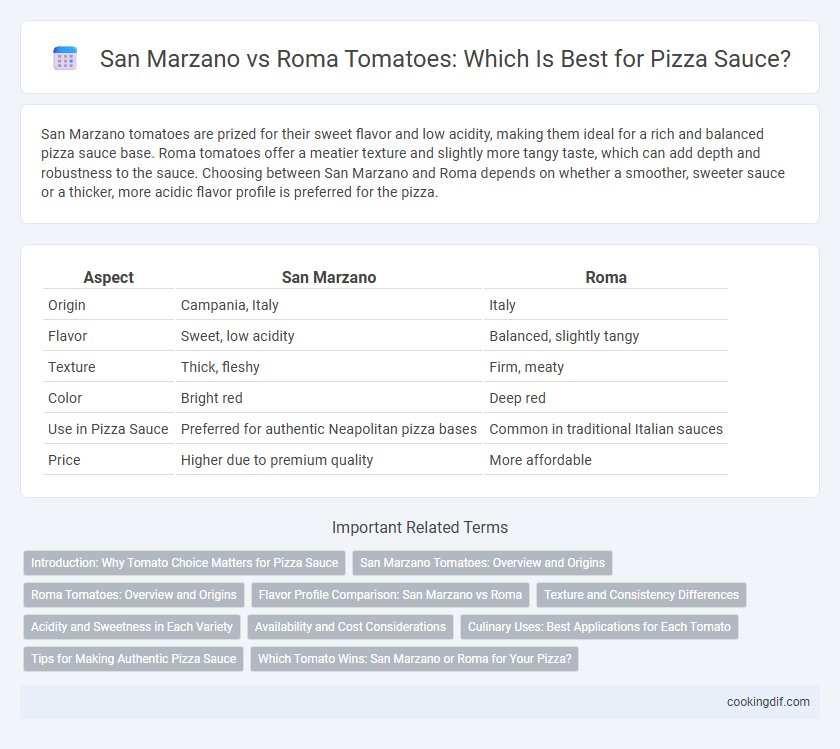San Marzano tomatoes are prized for their sweet flavor and low acidity, making them ideal for a rich and balanced pizza sauce base. Roma tomatoes offer a meatier texture and slightly more tangy taste, which can add depth and robustness to the sauce. Choosing between San Marzano and Roma depends on whether a smoother, sweeter sauce or a thicker, more acidic flavor profile is preferred for the pizza.
Table of Comparison
| Aspect | San Marzano | Roma |
|---|---|---|
| Origin | Campania, Italy | Italy |
| Flavor | Sweet, low acidity | Balanced, slightly tangy |
| Texture | Thick, fleshy | Firm, meaty |
| Color | Bright red | Deep red |
| Use in Pizza Sauce | Preferred for authentic Neapolitan pizza bases | Common in traditional Italian sauces |
| Price | Higher due to premium quality | More affordable |
Introduction: Why Tomato Choice Matters for Pizza Sauce
San Marzano tomatoes, prized for their balanced sweetness and low acidity, create a rich, flavorful pizza sauce base ideal for authentic Neapolitan-style pizza. Roma tomatoes offer a denser flesh and fewer seeds, producing a thicker sauce with a robust, slightly tangy taste suited for heartier pizza varieties. Choosing between San Marzano and Roma tomatoes directly influences the sauce's texture, flavor profile, and overall pizza quality.
San Marzano Tomatoes: Overview and Origins
San Marzano tomatoes are prized for their rich flavor, low acidity, and firm texture, making them a top choice for authentic Italian pizza sauce. Originating from the volcanic soil near Mount Vesuvius in the Campania region of Italy, these plum tomatoes have a protected designation of origin (PDO) status, ensuring genuine quality and traceability. Their natural sweetness and balanced acidity provide a robust base that enhances the overall taste of traditional Neapolitan-style pizza sauces.
Roma Tomatoes: Overview and Origins
Roma tomatoes, known for their dense flesh and low moisture content, are a favored choice for pizza sauce bases due to their rich flavor and thick consistency. Originating from Italy, Roma varieties have been cultivated for generations and are prized for their balanced acidity and natural sweetness. Their firm texture allows for a robust sauce that complements the crispy crust and melty cheese of classic Italian pizzas.
Flavor Profile Comparison: San Marzano vs Roma
San Marzano tomatoes boast a balanced flavor profile with a perfect blend of sweetness and acidity, enhancing the richness of pizza sauce. Roma tomatoes deliver a robust, tangy taste with a slightly firmer texture, making the sauce denser and more savory. Choosing San Marzano results in a smoother, more refined sauce, while Roma provides a bold, hearty finish that stands out in traditional pizza recipes.
Texture and Consistency Differences
San Marzano tomatoes offer a smooth, thick texture with a low seed count, making their sauce rich and velvety, ideal for classic Neapolitan pizza. Roma tomatoes feature a denser flesh with slightly more seeds, resulting in a firmer, chunkier sauce that holds up well during baking. The consistency difference impacts the overall mouthfeel, with San Marzano providing a silkier base and Roma delivering a hearty, robust texture.
Acidity and Sweetness in Each Variety
San Marzano tomatoes are prized for their balanced acidity and natural sweetness, offering a mild but rich flavor ideal for pizza sauce bases. Roma tomatoes generally present higher acidity with a slightly tangier taste, which can add a sharper edge to the sauce. The choice between San Marzano and Roma depends on whether a sweeter or more acidic sauce profile is preferred for the pizza.
Availability and Cost Considerations
San Marzano tomatoes, prized for their rich sweetness and low acidity, are often more costly and less readily available due to their protected designation of origin from the San Marzano region in Italy. Roma tomatoes, widely cultivated and more accessible, provide a budget-friendly alternative with a slightly tangier flavor and firmer texture suited for tomato sauce bases. Choosing between San Marzano and Roma depends largely on balancing the premium cost and limited availability of San Marzano with the affordability and widespread supply of Roma tomatoes.
Culinary Uses: Best Applications for Each Tomato
San Marzano tomatoes, prized for their sweet flavor and low acidity, excel in traditional Neapolitan pizza sauce, delivering a rich and balanced taste ideal for slow-cooked sauces. Roma tomatoes, known for their firm flesh and denser texture, are better suited for thicker sauces and recipes requiring a pronounced tomato presence, such as chunky pizza bases or rustic toppings. Both varieties offer distinct culinary applications, with San Marzano enhancing smooth, flavorful sauces and Roma providing robust texture and flavor intensity.
Tips for Making Authentic Pizza Sauce
San Marzano tomatoes offer a balanced sweetness and low acidity, ideal for creating a rich, authentic pizza sauce that enhances traditional Neapolitan flavors. Roma tomatoes provide a drier texture and more robust flavor, making them suitable for thicker sauces with intense tomato presence. For authentic pizza sauce, blend San Marzano for smoothness with a touch of Roma to achieve the perfect consistency and vibrant taste, using fresh garlic, basil, and high-quality extra virgin olive oil.
Which Tomato Wins: San Marzano or Roma for Your Pizza?
San Marzano tomatoes, grown in the volcanic soil near Mount Vesuvius, are prized for their balanced sweetness and low acidity, making them ideal for authentic Neapolitan pizza sauce. Roma tomatoes, known for their dense flesh and lower moisture content, create a thicker, heartier sauce that holds up well during baking. While San Marzano offers a rich, nuanced flavor perfect for classic recipes, Roma provides robust texture and concentration, appealing to those who prefer a more substantial sauce base.
San Marzano vs Roma for tomato sauce base Infographic

 cookingdif.com
cookingdif.com